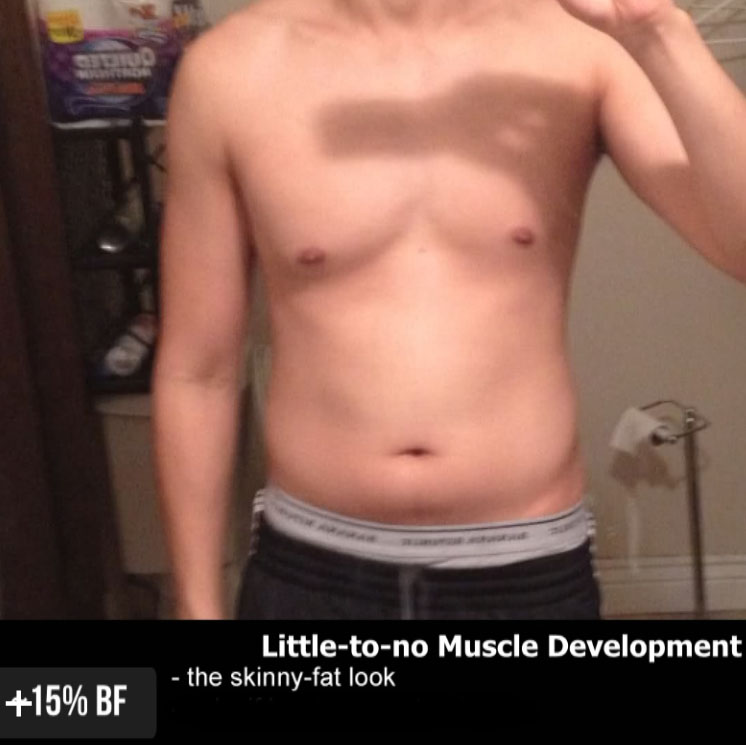Skinny fat is the term describing an individual that is carrying a higher than normal body fat percentage with little to no muscle mass on their frame.
Generally, the fat is stored around the belly, lower back and chest area with skinny looking arms and legs.
There are many causes that lead to a skinny fat physique such as neglecting nutrition, high stress levels, inadequate sleep, lack of exercise or a combination of all, but now you want to make a change, so what’s the best route to take?
Should you bulk (growth phase) or cut (fat loss phase) first?

Traditional Bulk & Cut Dieting is Outdated
Traditional bulk-and-cut diets are antiquated and inefficient.
You’re probably thinking ( as I have in the past) “I’m going to eat a ton of calories and get massive and then I’ll cut all my fat away and look shredded and huge.”
You know what really happens? Your bulk ends up leaving you looking like the Michelin Man, and your cut leaves you looking like a marathon runner.
Thing is you don’t need to add layers of fat to add muscle, nor do you have to burn muscle to lean out.
Your nutrition should create an environment where your food goes toward building muscle, not being stored as fat.
The traditional bulking diet does the opposite of this: By always staying in a caloric surplus, your body becomes used to storage.
The fatter you get, the fatter your body allows you to become.
The Solution to Skinny Fat: Recomp Phase
A re-composition( or recomp for short) phase is designed to place your body in an environment where it uses fat as fuel, while building some lean tissue in the same time.
“What’s the secret?” You work with your body.
Fluctuating between periods of caloric deficit and caloric surplus will maximize the anabolic response of training on workout days while facilitating fat loss on off days.
By playing off the interaction between these anabolic and catabolic processes, you can achieve the best physique of your life.
How does that work?
Nutrient timing will be of utmost importance for you, primarily carbohydrates.
The best time to have carbs in this situation is immediately post-workout only.
Resistance training temporarily signals the increase of anabolic hormones in the body which among other benefits, increases nutrient partitioning.
This results in the post-workout meal to be shuttled into muscle cells rather than fat cells.
Post-workout meal should consist of carbs and protein with minimal fat.
Post-workout nutrition replenishes the muscle glycogen stores to kick-start the recovery process, optimizing your performance for the next training session.
The remaining of your meals should come from lean protein and healthy fats from whole food sources.
Eating a primarily fat (and protein) based diet, your body will learn to prioritize fats as the primary source of fuel instead of carbohydrates.
Processed foods or foods that come in boxes/packages should be avoided.
Often, they contain weird substances and additives that disrupt the digestive system and negatively impact your overall health.
Why not just “bulk” first?
Note* “Bulk” or “bulking” is referred to eating in a calorie surplus as a way to build muscle.
There are many reasons why “bulking” to gain lean tissue is not most optimal when you are skinny fat:
- Poor nutrient partitioning, favoring fat stores deposit
- Sub-optimal hormone levels – higher estrogen levels, lower testosterone levels
- Poor insulin sensitivity – insulin is the main energy storing hormone in the body
- Eating in a caloric surplus has a point of diminishing returns. As you body-fat increases, the excess calories will be mainly be stored in fat cells.
- Excess total body inflammation
These are some of the possible consequences of having an unfavorable body composition.
The guideline to follow is right around 12& body-fat, the body’s ability to build lean muscle optimally starts declining.
As that body-fat percentage increases, so does its ability for fat gain.
Fasting
Fasting is an additional tool that can be extremely beneficial to your overall results.
- Improves insulin sensitivity (better nutrient partitioning)
- Potentially increases testosterone levels
- Improves gut function/digestion
- Allows for longer periods of time to burn fat as fuel
- Promotes autophagy (repair of damaged cells and regeneration of new cells). Autophagy can promote tightening of loose skin.
Since it takes about 12 hours to fully digest the last meal, fasting should be done for at least 14-16 hours.
Some go as long as 72 hours before the benefits begin stalling.
Intermittent fasting is a great method to use for turning the skinny-fat bod into a work of art.
Takeaway message
You can work towards muscle gain and fat loss at the same time (aka re-composition, or “recomp” for short), even though you’ve probably been led to believe differently.
Especially as a beginner, your muscles will be extremely sensitive to any stimulus given.
Your entire first year of training should be full of constant progress and results.
If this is not the case, I recommend you hire a knowledgeable coach to help you achieve your best physique. This will save you a ton of possible pain and discouragement.
Once you beat the skinny fat syndrome and achieve a lean state with some extra muscle tissue on your frame – 12% or lower body fat percentage – now will be a good time to switch gears and go all out solely on growing.
Cycling calories and nutrient timing still applies in order to minimize unnecessary fat gain and maximize lean muscle gain.
Want to take the guess work out of the equation and get straight to the results?
Join my Online Coaching Program and get started within 24 hours.
Simply book your free virtual consult today and we’ll get you started.



